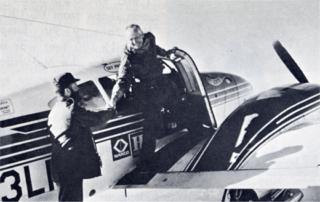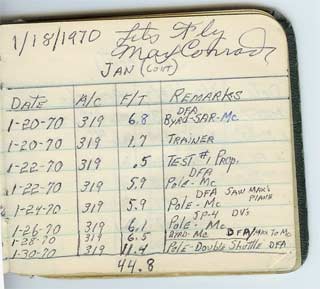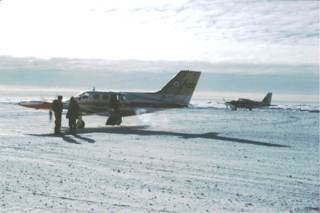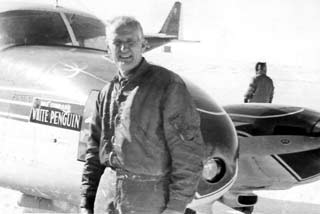Max Conrad at Pole
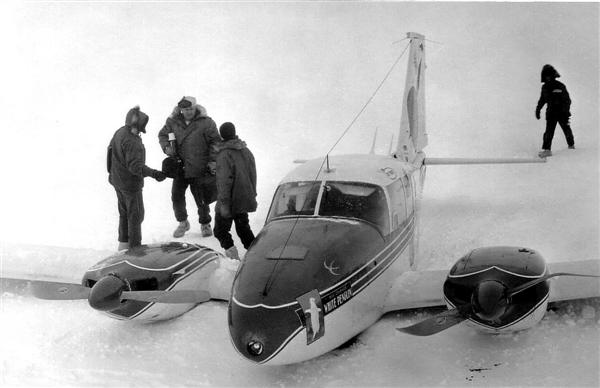
|
Above is the scene shortly after Max Conrad's crash landing at Pole on 23 January 1970 (BL [photo credits are detailed on the second page])...note the damage to the port propeller. Who was Max Conrad and how did he get to this point on his second attempt to fly around the world via the Poles? A bit of explanation, if only to demystify some of the sights and sounds of his unfortunate visit to Pole... Max Conrad was born in 1903 in Winona, Minnesota, and after Lindbergh's 1927 transatlantic flight he decided to become a pilot. He was already a musician, and the original idea was that it would be much more practical to transport his orchestra by plane instead of by bus. In 1929, shortly after becoming a flight instructor, he was seriously injured after he tried to rescue a passenger who was walking into the spinning propeller. The passenger was killed; Max suffered a fractured skull from which it took years to recover. During this period he used music and singing as mental therapy and to help him regain his speaking voice. He also learned to play at least 7 instruments. He married in 1931 and slowly reopened his flying school, and as World War II approached he was put in charge of organizing a series of government flying schools. In 1943 he became the chief pilot for Honeywell in Minneapolis; in 1948 he ventured across the Atlantic in a new Piper Pacer to visit his family which had gone to live in Switzerland. Not a good idea--the aircraft was impounded in Thule where he was thought to be a spy. He was freed and rejoined his family, and this venture turned into the start of his lifetime partnership with aircraft manufacturer William Piper.
Max became involved with the Antarctica for the first time in late 1966 when he was hired as a charter pilot for a private group planning the first ascent of Mt. Vinson. The FAA insisted that he needed a twin-engine "stock" aircraft rather than his single-engine Comanche, so he purchased (with help from Piper) the Aztec which he named named "St. Louis Woman" for one of his daughters. He did make one flight from South America across the Drake Passage to the Ellsworth Mountains, but the venture was then cancelled when the USARP-sponsored expedition had reached the summit. Now Max became interested in going around the world via the Poles. By now he was known as the "flying grandfather" (a term he disliked) because of his 10 children and 26 grandchildren. "St. Louis Woman" was extensively modified, fitted with cabin and wing tip tanks giving a total capacity of 476 gallons, and given the registration N123LF--the "LF" standing for his motto "Let's Fly." He obtained official permission from the U. S. Navy for the flight, with a bit of help from fellow Minnesotan (and Vice President) Hubert Humphrey. Conrad left St. Louis on 1 November 1968; his route over the North Pole included stops at Barrow and ice station T3 (where he suffered severe frostbite to his hands while deflating his tires to keep them from freezing to the ice). He then flew down across Europe and northwest Africa before crossing the Atlantic for Buenos Aires. Here he installed skis (which he had left here in 1966 after the aborted Mt. Vinson venture), and continued to PA, as seen in the photos below (JTA) at what was then the Chabunco Airport (now the President Carlos Ibaņez del Campo Airport) at PA. | |
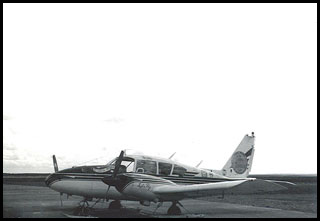 |  |
His next leg was to be a nonstop 1000-mile leg to Adelaide (the British station at the south end of that island, near the current Rothera). He tried to head south on 15 December, but he turned around at a reported latitude of 65°-15'S, after he had descended to a low altitude in fog and rain. On 21 December he left PA again and landed at Palmer after a 9-plus hour flight. | |
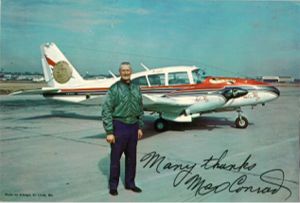 |  |
|
Above is Max's expedition postcard for the 1968 attempt. Max had 5000 of these printed up and sold for $2 each before this first flight. Eventually he brought them to Pole on his second try; this card was cancelled the day before the crash (here is an overenlarged view of the back of the card showing the itinerary and cancellation) (BA). Before preparing for his second trip, Conrad had long negotiations with the U. S. Navy, which didn't want him to go again. But thanks to the intervention of Senator Barry Goldwater, Conrad was given permission to land at Pole. He had a new itinerary, he renamed the aircraft "White Penguin," and he presold a new $2 postcard (below) although it carried the aircraft photo from the previous year. | |
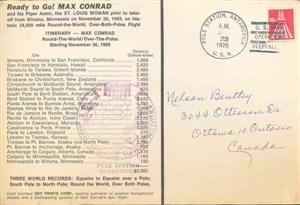 |  |
|
The itinerary was altered to include a couple of extra stops for engine repairs, but he made it to Christchurch in early January 1970. From there he headed to Invercargill, from where he left for McMurdo escorted by VXE-6. The first time he was forced to turn around when one of his engines lost oil pressure. After an overhaul, he tried again on 12 January, landing at Williams Field around midnight--with a flat tire--below left--a photo from this March-April 1970 Antarctic Journal article, and below right, a U.S. Navy photo from the DF-70 cruisebook (both BA). | |
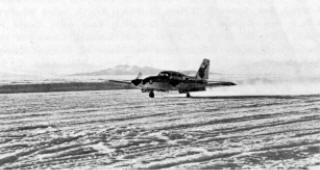 | 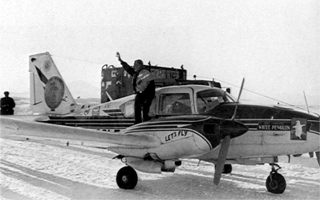 |
|
Max then had to wait around for reconfirmation to the Navy that his aircraft would perform satisfactorily at a gross weight of 6600 lbs. Meanwhile, on 18 January he scored a boondoggle round-trip flight to Byrd aboard one of the VXE-6 130's...as documented when he autographed a log book for Len Bourgeois (LB), one of the Navy flight crew (below right). A stop at Byrd Station after leaving Pole was part of Max's original flight plan. "So he came to Christchurch, was living in his airplane and we invited him to stay with us. And it so happened that Mary [Kelly's wife] was a classmate of his niece. And had met him before. So he came out and stayed with us. And eventually he flew to McMurdo and we flew the C130 along and gave him steering instructions. Said come left or come right and so forth. And we did the same thing on his way from McMurdo to South Pole. And he landed at the South Pole. He got there with his aircraft. But when he took off he crashed at the South Pole. He was going back to the Antarctic Peninsula. How he was going to get there I don't know because he had instrumentation on his aircraft but he couldn't use it. He didn't know how to use it..."
| |
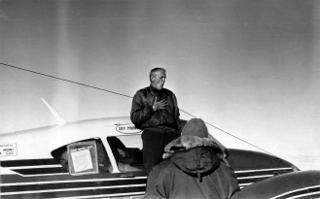 | 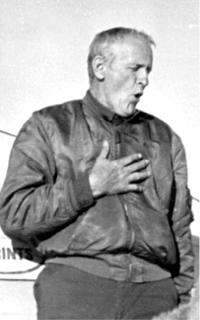 Here Max is at Pole. Yes, he's singing. Not exactly wearing ECW, wonder how his voice is holding up. What was he singing? I don't know, but here's a video of the title song "Let's Fly" from that album, which is still out there on used record sites. |
 | 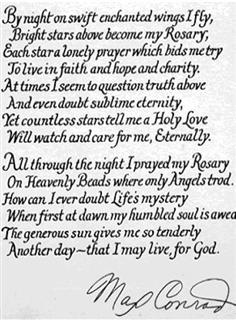 At left, an enlargement of the cabin window, and at right is another, more readable version of what is in the window--a sonnet which he developed during his long hours aloft. This original image is no longer on the Max Conrad website, but Max's May 1979 obituary in The Avion (Emery Riddle Aeronautical University) also depicts a sonnet image. Fortunately the Good Lord smiled upon Max later in the day, as he escaped injury in the mishap. |

